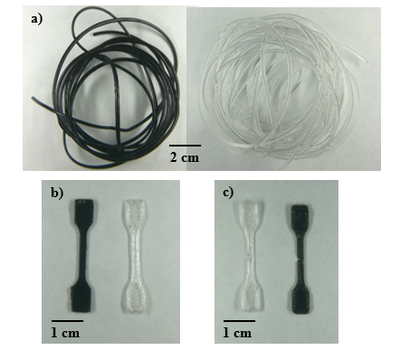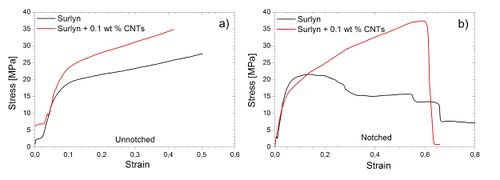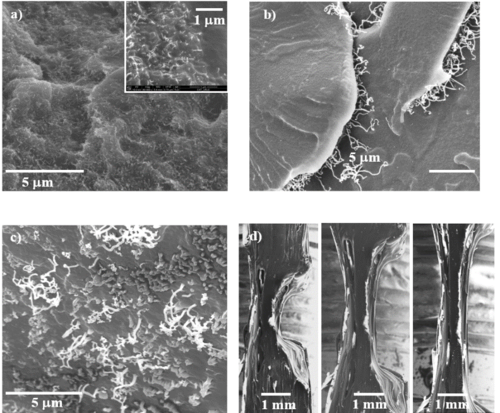1 Introduction
EMAA copolymer neutralized with sodium salt is a ionomer with well-known self-healing[1] and shape-memory properties[2,3]. However, the main drawback of this type of polymer to widespread its industrial applications is its low mechanical properties. The Young´s Modulus of the material is just in the range of 280-380 MPa and the yield strength and tensile strength are 15 MPa and 33 MPa, respectively. Therefore, the main objective of this work is to 3D printing EMMA polymer reinforced with multiwall carbon nanotubes (MWCNTs) to improve the mechanical response of the ionomer matrix.
2 Experimental procedure
2.1 Filaments manufacturing by extrusion
Filaments were manufactured using a polymer extruder. In the case of the unreinforced filament, Surlyn® pellets were used as raw material. The extrusion temperature used after the optimization of the extrusion parameters was 125 ºC. An extrusion die with a diameter of 1.75 mm was used to produce filaments with the same diameter to feed the 3D printer.
In the case of the nano-reinforced filament of Surlyn® with multiwall carbon nanotubes, a mixer was used. MWCNTs with an average diameter of 9.5 nm and length of 1.5 μm from Nanocyl were added to a Brabender® mixer (Haake Rheocord 9000) in a 0.1 wt. % proportion after reaching the melting of the ionomer. The temperature used for manufacturing this blending was 120 ºC. The blended mass obtained was cut into pellets, that were subsequently added to the filament extruder as feedstock material. The extrusion of the nanocomposite pellets was conducted increasing the temperature to 135 ºC to increase the fluidity of the polymer through the extrusion die.
2.2 3D-printing of the samples
Samples were 3D printed with a Witbox printer from BQ company, using the fused deposition modeling technology[4]. Samples were printed at 200 ºC in the case of pure ionomer and 220 ºC for the reinforced samples using the filaments previously obtained by extrusion. These temperatures were previously optimized in the lab. The dimensions of the samples were 35 x 2 x 1 mm and the geometry used was specified in the ISO-527-2:1993 5B standard for tensile test samples. To obtain the best tensile properties, the printed filaments were oriented longitudinally and parallel to the loading direction, due to the superior mechanical properties of this pattern [5]. The clamping zones were printed following a 0º+45º-45º filament orientation. Notched samples with the notch in the central zone of the specimen were also designed and printed.
2.3 Mechanical testing of the samples
Samples were tested using a micro-tensile testing machine from Deben with a load cell of 20 N. The machine was placed inside the SEM for load–displacement measurements and the simultaneous in-situ observation of crack progression and sample deformation of the tested specimens. Tensile tests were conducted using 1.5 mm/min as deformation speed. 3 specimens were tested for each condition to obtain representative mechanical properties.
2.4 Dispersion analysis of the nano-reinforcement
Surlyn® filaments reinforced with MWCNTs and the final 3D-printed specimens after being notched were introduced for 5 minutes in liquid nitrogen and subsequently fractured to analyze the dispersion of the reinforcement inside the polymer matrix using a FEG-SEM microscope (Nova Nano SEM230).
2.5 Self-healing ability testing
Several indentation damages were done in the specimens in order to determine the self-healing ability. Hardness tests using Shore D standard ASTM D2240-05 [6] were conducted on the surface of the specimens, using a maximum load of 10 kg applied during 10 s. 3D optical profiler and a software was also used to calculate from 3D micrographs the self-healing ability of the material in terms of volumetric percentage (V %), equation 1:
where Vo is the volume caused by the indentation and Vf is the volume of the damage after the application of the thermal healing treatment, i.e. heating in oven at 80 ºC for 1 h as optimized in previous research [7].
3 Results and discussion
3.1 Polymer filaments
Filaments of 1.75 mm of diameter were manufactured by means of a polymer extruder from pellets of the Surlyn® ionomer. The extrusion parameters were optimized to obtain a homogeneous filament in terms of composition and diameter. Fig. 1a shows the obtained filament (right image). The material is transparent, as the original pellets, and free of imperfections or air gaps inside. The material consistency is similar to that obtained using a hot plate to produce plates of material[7]. Meanwhile, the MWCNTs reinforced filament is completely black (Fig. 1a, left image), revealing the good dispersion of the nano-reinforcements achieved in the thermoplastic matrix using the pre-mixing chamber and the subsequent extrusion step. The filament was homogeneous in its whole extension and free of air gaps or imperfections.
3.2 Tensile test specimens 3D-printed
3D printing process was used to create the tensile test specimens. These retained the original color of the filament (Fig. 1b), indicating the absence of thermal degradation in the thermoplastic polymer during the printing process. The good distribution of the nano-reinforcement was also conserved as shown in Fig. 1b. In the central section of each tensile specimen, the fused filaments of polymer were well joined between them, without gaps that could cause subsequent stress concentrations in the sample.
3.3 Mechanical properties and self-healing ability
Fig. 2 shows the stress-strain curves obtained from the unreinforced and the MWCNTs reinforced 3D-printed samples. Table 1 collects the most important mechanical properties of the specimens. The results show the higher mechanical properties of the nano-reinforced polymer (Fig. 2a) with higher stresses needed to elongate the specimens in the case of the reinforced polymer, revealing the higher mechanical properties achieved and the good distribution of the nano-reinforcements inside the matrix. Notched samples were also tested (Fig. 2b) to evaluate the elongation at break and the tensile strength of the specimens, otherwise, the maximum load is reached in the unnotched samples, as can be seen in Fig. 2a, and these mechanical properties of the materials cannot be characterized.
Young´s Modulus of the 3D-printed specimens is in the same range of values of the as-received material, revealing no degradation of the polymer because of the double thermal procedure, i.e. mixing, filament extrusion and printing. The same tendency was obtained for the yield strength of the printed specimens, but a clear decrease in the elongation was obtained for the printed materials, from 4.7 to below 1 for the notched tested samples. The change in the fracture mode from ductile (unnotched sample) to fragile (notched sample) is a common phenomenon in thermoplastic polymers.
Tensile strength of the unreinforced polymer decreased a 45 % after the printing process of the unreinforced polymer, but the mechanical property is recovered due to the beneficial effect of the MWCNTs added to the polymer. The improvement in the mechanical response of the nano-reinforced polymer is clearly seen in Fig. 2b regards to that of the unreinforced polymer.
Table 1 shows that the ability of the EMMA polymer was not altered during the filament manufacturing and the subsequent 3D printing process. The polymer maintains its ability to heal indentation damages.
* Dupont datasheet.
- Hot-plate manufactured material from pellets.
3.4 Fracture characterization
Fig. 3a shows the fracture surface of the extruded filament and the good dispersion of the MWCNTs in the polymeric matrix. It can be seen how MWCNTs are perfectly embedded in the matrix (insert). The beneficial effect of the CNTs in the printed samples is seen (Figs. 3b and 3c). Good dispersion of the reinforcements was maintained during the printing process. Some of the MWCNTs were partially pull-out during the breaking of the specimen, increasing the tensile strength of the final nanocomposite, but maintaining some of the length of the MWCNTs immersed in the matrix, indicating the good adhesion with the matrix.
Fig. 3d collects different micrographs obtained during the tensile test of the reinforced 3D-printed specimen. An improvement of the mechanical properties due to the nano-reinforcements addition regards to that of the unreinforced one was obtained, as confirmed by the tensile strength values of the materials. There is no loose of integrity during the test in the specimen or decohesion between the fused filaments of the specimen, with the whole specimen reacting to the applied stress.
4 Conclusions
Filaments of pure and MWCNTs reinforced EMAA polymer have been manufactured by 3D-printing technology. The obtained specimens were free of thermal degradation. The nanoreinforced EMMA material presents a good dispersion of the MWCNTs and the mechanical properties of the test samples have been improved by increasing the Young’s Modulus and the tensile strength. A reduction in the elongation ability has been observed in the notched samples due to the fragile fracture mode promoted. The self-healing ability of the ionomer was maintained after the addition of MWCNTs and the printing process.
Acknowledgements
Authors acknowledge the financial support received from Comunidad de Madrid (Multimat-Challenge project, S2013/MIT2862). L. Peponi thanks MINECO for her “Ramon y Cajal” contract, RYC-2014-15595.
References
- [1] D.Y. Wu, S. Meure, D. Solomon, Progress in Polymer Science, 33, pag 479–522 (2008).
- [2] K. A. Cavicchi, M. Pantoja, M. Cakmak, Polymer Physics, 54, pag 1389–1396 (2016).
- [3] Q. Zhao, H.J. Qi, T. Xie, Progress in Polymer Science , 49–50, pag 79-120 (2015).
- [4] J.R.C. Dizon, A. H. Espera Jr., Q. Chen, R. C. Advincula, Additive Manufacturing, 20, pag 44–67 (2018).
- [5] S. Guessasma, S. Belhabib, H. Nouri, O.B. Hassana, European Polymer Journal, 85, pag 324–340 (2016).
- [6] ASTM D2240-05 Standard Test Method for Rubber Property-Durometer Hardness. 2010.
- [7] G.R. Mettam, L.B. Adams, Healing ability of ionomeric polymers under low-energy transfer damages, in: Laura Peponi, Jean Marie Raquez (Eds.), How smart are the polymers, Nova Science Publishers, New York, pp. 149–174 (2018).
Document information
Published on 01/06/22
Accepted on 01/06/22
Submitted on 28/05/22
Volume 04 - Comunicaciones Matcomp19 (2020), Issue Núm. 1 - Avances en Materiales Compuestos. Nuevos Campos de Aplicación., 2022
DOI: 10.23967/r.matcomp.2022.06.009
Licence: Other
Share this document
Keywords
claim authorship
Are you one of the authors of this document?



